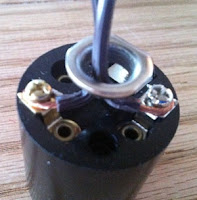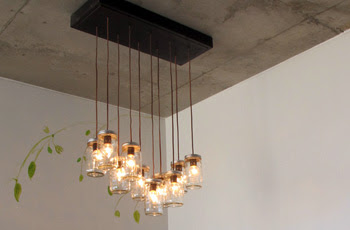 |
| Mason Jar Chandelier |
Before I went about an actual design, I searched the web to see if anyone had built a chandelier made from mason jars or similar. I came across several do-it-your-selfers. The best was posted by Our Hiding Place which led me to Pottery Barn's Exeter 16 Jar Pendant Chandelier. It's a really nice design and lists for $399. I was determined to customize mine and make it for less but I wanted detailed step-by-step instructions and I wasn't finding them anywhere.
I swore that if my project was successful I would share it with others. I apologize in advance for the quality of the instructional pictures; I was too excited during the building process to focus on picture taking. What follows are instructions on building your own mason jar chandelier based on the one pictured above. (Full steps are also listed on Instrcuctables.)
First thing I did was to determine how much light I needed and what the electrical requirements would be. (Disclosure: I am not an electrician and am not recommending voltage or wiring. Each State has their own codes regarding home wiring. Also, the following instructions will not guide you on how to wire the ceiling leads and wall switch.)
The space where I planned on having the chandelier is over my dining/art table. (I built the table to again, suit my particular needs.) There is an existing electrical port in the ceiling that unfortunately, due to inept design is positioned too close to one wall restricting the width of a ceiling fixture. After identifying the maximum voltage I could then decide on the number of jars and matching bulb wattage. (Voltage, watts and amps are different. Again, I am not an electrician but am lucky enough to have a friend who is one hell of an incredible licensed electrician. If you don't know what you're doing, consult a licensed electrician.)
Based on my space and lighting needs, I decided on 10 jars with 25 watt bulbs. (Before you decide on the jars and the bulbs make sure the bulbs will fit inside the jars.) I tested different jars and bulbs first, before committing to the final design. I wanted to make sure that the heat generated from the bulbs wouldn't cause the jars to break or create condensation inside the jars. For the tests I purchased a simple lamp cord kit from the local hardware store. (It's a cord with a plug on one end and a socket on the other.) I already had a couple of mason jars on hand. My test proved successful so I ordered the rest of the needed parts. (See list below.)
I decided to drill and wire the jars first, build the unit that would house the wiring after and then mount it to the ceiling. Being married to a hat designer helps with measurements. Together, we created a pilot hole template to drill through the lids of the jars where half of the metal nipple and wire passes through.
 |
| Thin part of lid (left). Paper pilot hole template (right). |
I placed the paper pilot hole template on each lid and then screwed the outer piece of the locking lid on and marked the centered hole in preparation for drilling.
 |
| Ready to drill lids. |
 |
| 1/8" Hex Nut & 1/8" Nipple |
Next, place a Hex nut on both sides of the lid and hand tighten before using a wrench to lock them into place.
 |
| Hex nuts wrenched tight top and bottom. |
My wife stepped in again to measure the center of the jars against the width and length of the 'junction' (ceiling) box so that the jars would be positioned proportionately. Holes will be drilled through the red circles in the below picture and the wires will go through them. The wires will ultimately be connected to the lead wires in the ceiling.
 |
| Drill hole marks in 'junction' (ceiling) box bottom. Portion shown will face the ceiling. |
(No, you're not crazy, I took the below picture before I wired the keyless sockets.)
 |
| Jars being centered on 'junction' (ceiling) box. |
With all of the lids drilled and the nipples locked down by the Hex nuts, it's time to wire the keyless sockets as pictured below. Make sure to pass one end of the wire through both parts of the lid, (Mason jars have air-tight lids by having two parts: one is the thin flat piece and the other is the screw-on cap) and then through the nipple. (We wanted the jars to hang 3' from the ceiling and cut the wire accordingly.) Before wiring to the two screws on the socket, you'll have to strip the wire covering with wire cutters. There is a positive and negative wire. It depends on the wire you choose as to which is which.
 |
| Wired Keyless Socket |
After the wire has been passed through both parts of the lid and the nipple, screw the keyless light socket onto the underside portion of the nipple. This is portion of the nipple that goes inside the jar. Screw the bulb into the keyless socket. At this point, your wiring and hardware should look like the picture below.
 |
| Lamp wire has passed through the screw cap and the nipple then wired to the keyless lamp socket. |
Each jar should now look like the below picture. Before attaching the other end of the wire to the ceiling wires, unscrew the lid and take the glass jar off. You don't want the extra weight at this point.
 |
| Wired socket and bulb in jar. |
One of the best products ever invented is probably the Electric Grounding Bar. I used it to 'piggyback' all ten of the wires into two. The two wires will connect to the lead wires in the ceiling. The grounding bar is screwed into the junction (ceiling) box bottom as pictured below. I placed the bars close enough to the lamp cords but far enough away from each other as not to create a short. The corded lamp wire is poking through the pre-drilled holes. You will be bringing each of the ten lamp wires through the pre-drilled holes in the box's bottom.
 |
| Electrical Grounding Bars with corded wire poking through. |
Next, split the corded lamp wire so that the two wires are separated from each other, enough to reach each bar. Strip away 1/2" of the wire's insulation and insert into an open hole in the bar. Hand tighten using a Phillips screw driver the bar screws so that each wire is screwed to one side of the bar as pictured below. Using electrical tape, cover any exposed wire.
 |
| Corded lamp wire split and screwed to grounding bars. |
 |
| View from above: all ten lamp wires screwed to grounding bar. |
 |
| View from side of the pre-painted bottom of junction (ceiling) box with attached wired sockets and jars. |
The most difficult part of this project was creating a box for the wires to be housed and that could be mounted to our concrete ceilings. I wanted to make this as simple as possible so I designed a topless box. You can make this any size you want. I wanted something as narrow as possible but deep enough to hold the wires and hardware. I cut a basic rectangle shape (see parts list below) using a 1" x 8" pine board for the bottom of the box and 1/2" x 2" poplar for the sides. I screwed the sides to the bottom using pre-drilled and countersunk holes and then screwed six 1/2" brackets to the inside portion of the box sides. The brackets were then screwed to the ceiling using a concrete drill bit and drill.
- 1 case of Kerr Wide Mouth, 16 Ounce Mason Jars - $22.45
- 10 Keyless light-holder socket - $3.49 each
- 10 GE 25-Watt Crystal Clear G16.5 Globe Candelabra Base Incandescent Light Bulb (4-Pack) - $3.87
- 10 - 1/8 Nipples - .10 each. Pictured going through the lid of the jar and screwed into the keyless socket. The lighting wire will pass through them.
- 20 - 1/8-27 Zinc Hex Nuts .05 each. Used to secure the lid and the nipples together. Nuts and nipples where purchased from the great folks at Grand Brass who were extremely knowledgeable and helpful.
- 2 Electric 9 Terminal Ground Bar Kit - $5.22
- Rayon or cotton covered lamp cord; 40 feet at $2 per foot. (You can find less expensive wire but I really like the old-timey look of the rayon or cotton covered wire. I purchased an extra 10' just "in case". You can find this at The Antique Lamp Company, eBay or Amazon. Learn from my experience and stay away from Sundial Wire. It took four weeks just to get samples from them and then they didn't return multiple phone calls or emails requesting information. Frustrated, I purchased mine at a local lamp parts store before coming across The Antique Lamp Company's website. If you purchase from them please let me know how your shopping experience was.)
- 1 x 8 x 6 pine board - $16.45 (I cut mine to 29" for the bottom of the 'junction box'. The left over cut has been put to good use on another project.)
- 1/2 x 2 x 4 Poplar board for sides of junction box - $2.67
- 1 box of #9 x 1" Flat Head wood screws - $1.24
- 1/2" brackets - $2.77 each (You can get them much cheaper.)
- Martha Stewart Black Coffee Metallic Glaze Specialty Finish - $5.48
- Electrical tape - $2
- Colored wood putty - $1.40
Tools:
- Wire cutters
- Phillips head screw driver
- Electric drill and 1/4" bit
- Hand saw


